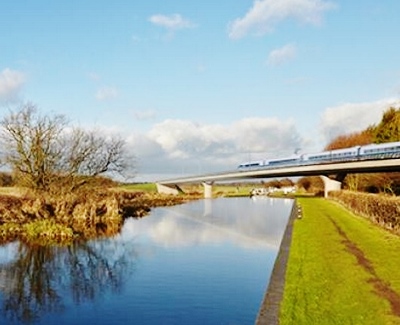HS2 Railway – What it could mean for Thame
On 01/02/2014 At 12:46 pm
Category : Missed a ThameNews story?, Thame news, travel
Responses : One Comment
WHAT is HS2?
HS2 (‘High Speed Two’), is a railway line which will go from London to Birmingham in its first phase. It is planned to be followed by a second and third phase, connecting the Midlands to the northern towns of Leeds and Manchester, and then to Newcastle and Edinburgh. The line is designed to cover long distances at a high speed with few stops, using modern high speed trains, similar to the ‘Eurostar’ or Japanese ‘bullet trains’.
So?
According to the official HS2 website, it will “revolutionise our railways, create thousands of jobs, bring major cities closer together, generate investment in neglected areas and provide passengers with an unprecedented travel experience”. It goes on to assert that an entirely new line is needed to provide greater and more efficient connectivity between the two largest cities in the UK. Anticipating further increased demand for Britain’s railways in the future, HS2 is also designed to reduce overcrowding on existing lines, which it is thought will improve local services and freight routes.
But…
There has, however, been extensive criticism of the HS2 proposals too, coming from across society. Many have accused numerous aspects of the HS2 case of being misleading. The ‘Stop HS2’ and ‘HS2 Action Alliance’ campaign groups have been particularly vocal in their opposition to the planned railway. There has also been opposition from across the political spectrum, despite the official support of all three main political parties to HS2. In addition to funding concerns, the Department for Transport has been accused of inflating the number of potential job creations, downplaying the environmental costs and ignoring alternatives and upgrades which could utilise infrastructure already in place.
How could it affect us?
Despite the massive coverage of HS2 there has been relatively little discussion of how it could affect Thame and the surrounding area. Thame is less than 10 miles from the planned route of HS2, as can be seen here. This has the potential to affect Thame and the surrounding area in a number of ways.
Environment
One of the most noticeable consequences of HS2 would be its effect as it crossed the Chilterns, cutting through the local Area of Outstanding Natural Beauty (AONB). This is currently a popular recreation and leisure destination for locals and visitors alike.
The Chilterns AONB Conservation Board has been particularly keen on drawing attention to the consequences that HS2 and its construction could have. The most obvious effect, from the Board’s and its supporters’ point of view is the track ‘scarring’ the landscape, and the noise pollution caused by the construction and trains.
As well as the construction of the track itself, HS2 will also involve the building of viaducts, tunnels, embankments and cuttings in, what is a protected AONB. These would be visible from local nature spots such as Coombe Hill, as well as the surrounding towns and countryside. Chiltern AONB believes that at least 3.79 miles of HS2 infrastructure will be visible within the protected area, contrary to HS2 Limited’s prediction of 1.5 miles.
It is estimated that the construction process would also cause nearly a million square metres of waste spoil. In addition, ancient trees and hedgerows are currently situated directly on the planned route. A number of rights of way, including The Ridgeway, The Icknield Way and the Chilterns Cycleway, would need to be intersected. In all, 13 Rights of Way, along with 13 roads, would need to be crossed by the route within the AONB.
History and Archaeology
As well as being naturally rich, the AONB area is also of historical and heritage value. HS2 will pass through an area scattered with listed buildings, medieval settlements and even Roman artefacts.
Particularly hard hit will be the remains of St. Mary’s Church and graveyard at the old village of Stoke Mandeville. This site would be “totally obliterated” by HS2 itself, and the construction of maintenance sidings directly on the site, according to the Buckinghamshire Archaeological Society (BAS). The BAS estimates that there may have been up to 3,900 human burials at the site over 650 years.
Flooding
As HS2 passes between Stone and Aylesbury, it will pass through an area at risk of flooding. HS2 has accommodated for this by planning two viaducts to carry trains over the floodplains just outside the town.
The Chiltern District Council’s Buckinghamshire Mitigation Blueprint for HS2 suggests that there is a chance that this construction could negatively affect the behaviour of flood water, potentially putting the western edge of Aylesbury at increased risk of flooding. Campaign group ‘Stop HS2’ go further, claiming that “a project with the landtake of HS2 will severely impact the potential for flooding, not just along the line but downstream on every river and watercourse affected”. The River Thame also intersects with the HS2 route.
The effect of construction and traffic on Thame
The Chiltern District Council has “significant concerns” about HS2’s impact on the safety and access of local traffic and transport during the construction period. For Aylesbury, it is thought that the consequences will be “severe”. The main route from Thame to Aylesbury, the A418, is likely to suffer diversions as HS2 is planned to go directly over it. This could affect commuters, shoppers and public transport links to Thame for an unknown period of time. It is feared that a number of lorries supporting the construction would cause damage and major disruption to local roads, especially as there are a limited number capable of supporting heavy vehicles. The number of vehicles that will used by HS2 staff are also considered a risk to the local road system.
Although HS2 is designed to benefit the whole country, its effects are likely be strongly felt in the Thame area, particularly in relation to traffic and the environment. It remains to be seen whether the disruption it would cause, would eventually be worth the national advantages that HS2 is projected to bring by its advocates, in the long term.
Written for Thame.Net by Will Worley



On thame.net, neither of the two links above work.
Much anti comment has focused on cost, disruption and scenic destruction. More has to be said about need. Business persons work while on a train and a small time saving is of no real value. The person traveling to see friends or relatives in either London or Birmingham is also unconcerned about time. Also, such travellers are likely to reduce in numbers as conference calls take over from direct meetings.
Further, where is an analysis of the passenger makeup on the current Chiltern route. That is to say, what proportion of passengers start in London or Birmingham and travel the whole distance, as opposed to getting on, and perhaps off at the intermediate Chiltern stations. These latter passengers get no benefit and are surely the greatest part of the customers.